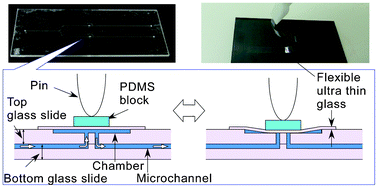In the field of “lab-on-a-chip”, sophisticated valves are extremely important to manipulate small-volume samples in a microchip. Currently, the most commonly used valves utilize polydimethylsiloxane (PDMS), exploiting its elastomeric property. Although polymer-based valves are very sophisticated and convenient, they also have several disadvantages such as chemical and physical instability and an inherent optical detection limit. With respect to these issues, glass is the most common material utilized to create multi-purpose integrated chemical systems. However, glass is very hard and difficult to incorporate valves into a glass microchip. To overcome this problem, I propose to use a very flexible, ultra thin glass sheet fabricated using an overflow fusion downdraw process to realize a minimum thickness of a few micrometers. In this report, I describe an ultra thin glass-based valve installed in an entirely glass-based microchip. Since ultra thin glass is very fragile, manipulation is difficult especially in liquid. Therefore, methods for ultra thin glass manipulation and fabrication using thermal fusion bonding were established. The valve function was demonstrated using bimorph-type piezo actuators. Valve function in a linear channel and switching valve function were demonstrated. The durable pressure was 3.0 kPa and the response time was about 0.12 s, which was shorter than that reported for similar previous PDMS-based valves. I expect that this device could be utilized for a wide range of applications that require a glass microchip.

You have access to this article
 Please wait while we load your content...
Something went wrong. Try again?
Please wait while we load your content...
Something went wrong. Try again?


 Please wait while we load your content...
Please wait while we load your content...